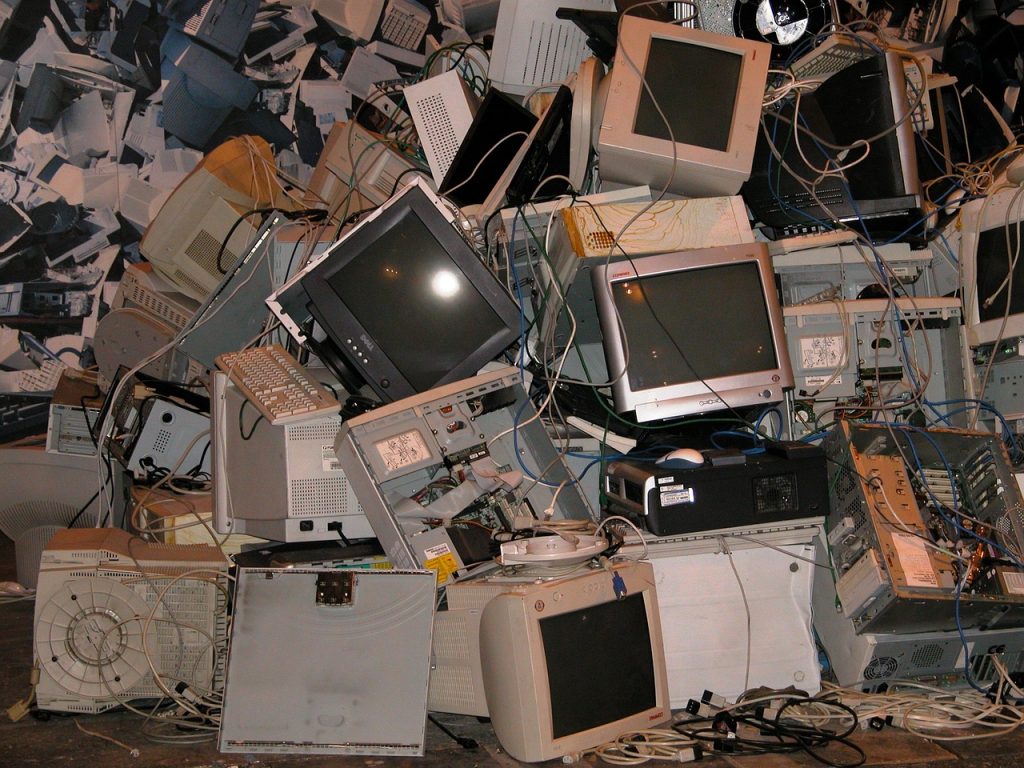- Understand the importance of recycling computer monitors due to harmful chemicals and valuable materials they contain.
- Research state-specific recycling laws and regulations.
- Gather old electronics and prepare them for recycling.
- Drop off old monitors at a certified recycling center or electronics retailer.
- Ensure different components of the monitor are recycled according to their type (e.g., glass, plastics).
- Utilize manufacturer drop-off points or recycling programs if available.
- Consider arranging junk removal services for efficient disposal.
- Donate, sell, or gift old monitors if they are still functional.
- Always choose reputable recycling programs to ensure responsible recycling.
- Spread awareness about the importance and methods of recycling computer monitors.
The Green Guide to Recycling Computer Monitors: Making the Most of Your Electronics Waste
If you’ve got an old computer monitor lying around, you might be wondering what the best way is to dispose of it. The answer isn’t to throw them in your regular trash bin though; it’s to recycle them properly. But how exactly do you recycle a computer monitor? Recycling computer monitors, like other electronics, requires a bit more effort and understanding than typical paper or plastic waste. That’s what this green guide is all about.
Recycling computer monitors is crucial for several reasons. First, they contain harmful chemicals that can damage both human health and the environment when they’re not disposed of correctly. Second, they’re composed of valuable materials like precious metals, plastics, and glass that shouldn’t go to waste. By recycling, we’re able to recover and reuse these materials, reducing the need for new resources and manufacturing processes that can harm our planet.
It’s important to note that recycling law varies from place to place, which makes state-specific recycling information critical. Different states have different rules regarding electronics waste, particularly for items like computer monitors. Some places, have strict rules and regulations, while others do not. This makes it important to consider your locations going forward.
The recycling process takes into account this information states provide, as well as the practical aspect of recycling. Once you’ve gathered your old electronics to be recycled, you can usually drop them off at a recycling center or even certain electronics retailers. Many of these destinations will take your old computer monitor and other electronics regardless of their condition, ensuring they’re properly processed and put to good use.
It’s also important to remember that, similar to other kinds of recycling, different components inside your old computer monitor require different recycling methods. For instance, glass from the screen might get turned into new glassware, while plastics could become new electronics enclosures.
Another consideration stems from the electronic manufacturer’s responsibility. In many places, the law requires manufacturers to play a role in this process. This legal obligation encourages them to create drop-off points for old electronics, as well as operate their own recycling programs. They often offer these services free of charge to the consumer, hoping to decrease the number of electronics lying around in waste dumps.
In conclusion, recycling a computer monitor isn’t just about maintaining a cleaner environment; it’s about making the most of your electronics waste. It’s an inexpensive and simple way to responsibly dispose of your old electronics while ensuring valuable materials stay in the economy. If we all did our part, think about the substantial impact we could make on our planet! Remember, recycling isn’t just a task—it’s a necessity. Whether it’s an old computer monitor or other used electronics, consider how you can recycle, recycle, and recycle again. Every effort counts, so let’s get to it!
How to Arrange Junk Removal for Computer Recycling
Learning how to recycle a computer monitor properly plays a critical role in promoting a green environment. In the course of recycling, you’ll inevitably encounter the need for junk removal, particularly when dealing with an array of electronic waste. Junk removal aids in the proper disposal of computer monitors, facilitating effective computer recycling. This green guide aims to ease and streamline the process for you.
Junk removal is a vital service when it comes to recycling. When you decide to recycle, you’ll need to dispose of your electronic waste. This is where the role of a reliable junk removal service comes in handy. First, you’ll need to identify a reputable service provider, known for efficient services in disposing of electronic waste. The uniqueness of electronic waste demands a well-equipped service that can handle the complexity of the items being disposed of.
Facilitating computer recycling demands tremedous effort, but it’s undeniably worthwhile. The disposal of computer monitors, for instance, should be done in strict adherence to environmental protection standards. You need to ensure that the service you choose for disposal is certified and follows all the requirements. Adherence to such waste disposal rules ensures that the waste doesn’t end up in landfills, which can result in severe harm to the environment.
Computer recycling is a comprehensive process that starts from the point of collection of the waste, transportation to the disposal site, and finally the actual recycling process. Each step is significant and demands professional handling. Thus, it’s essential to only employ a service that has gained a reputation for efficiency in their services and is also knowledgeable in the proper disposal methods for electronic waste.
After arranging junk removal, you can expect the provider to prioritize proper disposal of the computer monitors. An excellent service will dispose of the waste in a manner that aligns with environmental conservation efforts. It’s important to note, disposal isn’t just about getting rid of the waste. It’s about ensuring that as you dispose, you do so responsibly. Good disposal techniques translate to effective waste management, which is beneficial to both you and the environment.
In conclusion, computer recycling is a significant process that requires proper handling to ensure environmental sustainability. Junk removal aids in disposing of electronic waste appropriately hence promoting responsible recycling. It’s an undertaking that’s more than just disposal. It involves choosing the right service, ensuring the process is properly handled, and adhering to the requirements set. So, as you plan to recycle, give junk removal the importance it deserves. This guide serves as a comprehensive walk-through for a greener future, one screen at a time.
The Benefits of Recycling LCD Computer Monitors
There are numerous benefits to recycling old monitors or computer displays, particularly those of the LCD type. The practice of monitor recycling isn’t just about being kind to the environment – it’s also a green way of reducing electronic waste, safeguarding your sensitive information, and even earning some extra cash. When you toss your old computer monitor in the trash, it doesn’t simply disappear. It lands up in a landfill where the dangerous heavy metals it contains can potentially harm the environment. Notably, an LCD (liquid crystal display) computer monitor contains valuable metals like gold, silver, copper and palladium which when recycled, can be reused in various industries.
The process of recycling involves salvaging valuable elements, using green and eco-friendly procedures to ensure they’re not wasted but reused to produce new products instead. Companies specializing in recycling computer monitors extract these precious metals and put them back into circulation. By doing this, we’re making the most of our electronics waste and contributing to a more sustainable future. In addition, recycling old monitors promotes job creation in the recycling industry and supports other businesses that use these recovered materials.
Another compelling reason to consider recycling your LCD monitor is the potential to earn a couple of bucks. Many recycling centers offer financial rewards to individuals who bring their old monitors for recycling. Furthermore, knowing that your old display won’t end up contributing to land pollution or contaminating waterways creates a sense of accomplishment and responsibility towards our planet.
Moreover, monitor recycling helps to safeguard sensitive data that may still be lingering inside your old device. Merely deleting files will not make them disappear completely. By recycling, you’ll be professionally dismantling the LCD, thereby mitigating the risk of information theft. In fact, certified recycling companies follow stringent guidelines and legislation set out by authorities, therefore, assuring your data safety.
It isn’t hard to comprehend the benefits of recycling LCD computer monitors. However, many people still dispose of their computer gear improperly. Luckily, the good news is, arranging for junk removal for computer recycling has become easier than ever. Many places offer recycling facilities where you can drop off your old monitor, or you can arrange for a door-step pick-up with a trusted and specialized recycling company.
In conclusion, recycling your old LCD computer monitor has substantial environmental, economic, and personal benefits. It represents an opportunity to participate in the drive towards an increasingly sustainable world. By choosing to recycle, we can collectively ensure that valuable resources are not wasted or dumped in a landfill, but responsibly recycled and repurposed.
Tips to Effectively Recycle Computer Monitors: Keeping the Waste Down and Getting the Most out of Recycled Screens
As we grow more environmentally conscious, the demand to recycle items, including computer monitors, increases significantly. To effectively recycle monitors and keep our waste down, we must mindfully donate them to appropriate channels that champion the green cause. By doing this, we’re not only reducing our waste footprint but also contributing to the availability of affordable, recycled screens for the less privileged.
Recycling LCD computer monitors, in particular, presents both program suitability and potential problems. These monitors contain valuable materials that can be reclaimed and reused, thereby making it vital to recycle them. But bear in mind, the recycling process isn’t as easy as discarding your regular household waste. Monitors have potentially harmful materials that necessitate specialized recycling practices.
The key to effective recycling lies in understanding the intricacies involved. Awareness about how to properly recycle your old computer monitors significantly reduces the potential risks to our environment. There are recycling programs available that specialize in handling electronic waste. These programs adhere to stringent guidelines and practices designed to minimize any environmental impact. We should capitalize on these programs whenever we have an old monitor to recycle. Remember, there’s no ‘away’ in throw away.
Being careful about where and how you recycle your computer monitors directly influences what becomes of them. Simply handing them over to a junk removal service doesn’t ensure they will be responsibly recycled. By knowing the right program to reach out to, we can increase the chances of these monitors being repurposed effectively and reduce unnecessary waste.
The next time you upgrade your old monitor; don’t just throw it away. Consider donating it to a reputable recycling program. You may also decide to sell or gift it to someone in need. Not only does this benefit the recipient, it is also a positive move for the environment. If your monitor is beyond salvage, ensure it’s recycled professionally. This limits the opportunity for harmful materials to escape into the environment as waste and promotes the reuse of valuable components.
The benefits we get from recycling computer monitors are multi-fold. It protects our environment from harmful waste, provides a source of affordable screens for those in need, and ensures the valuable materials contained in these monitors are re-utilized. We should be proactive in donating our old monitors to suitable recycling programs and spread awareness about the need to do this. Knowledge is power, and in this context, it’s green power.
As we go through the exciting technological advancements of our age, it is incumbent upon us to do our part in minimizing the detrimental environmental impact. Effectively recycling computer monitors is one of the tangible steps we can take towards this goal. Start the green revolution at home- recycle your monitors, recycle responsibly, and encourage everyone around you to do the same. We owe it to the generations yet to come; let’s not squander this opportunity.




